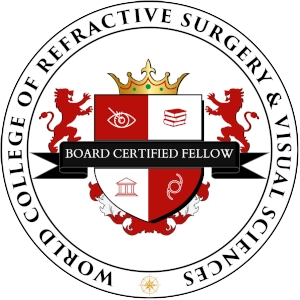Laser Lens Exchange
Precision surgery with the femtosecond laser
The Laser Lens Exchange at a Glance
- Areas of application:
Cataract removal (cataract surgery)
Correction of presbyopia and simultaneous nearsightedness or farsightedness - Disadvantage: Loss of accommodation ability
When the body's own lens is replaced, the eye loses its ability to focus at different distances (accommodation). The distances at which you can see clearly without glasses after the operation depend on the lens type implanted. - Intraocular lenses for high visual comfort
There's a variety of lens types available, each which specific properties. Which type of lens is best for you depends on your needs and expectations; You will discuss this personally with your surgeon.
How does the surgery work?
Lens replacement is an outpatient procedure that requires only eye drops for anesthesia. Typically, both eyes are operated on 1–2 days apart.
The procedure is based on decades-old, proven techniques used to treat cataracts. During the surgery, the natural lens is removed and replaced with a multifocal lens.
At FreeVis, we utilize a femtosecond laser for the first four steps of the procedure:
1. Lens liquefaction: The laser softens the natural lens.
2. Capsule opening: A precise circular opening is made in the lens capsule.
3. Corneal incision: A small peripheral incision is created in the cornea.
4. Astigmatism correction: If necessary, the laser corrects accompanying astigmatism.
After the lens material is aspirated, the multifocal lens is folded and injected into the eye. It unfolds into position, replacing the natural lens. This technique is also routinely used for cataract removal, making it a highly reliable and proven procedure.
The video demonstrates how the use of the LensX femtosecond laser can improve the outcome of cataract surgery.
Choosing the best intraocular lens: Monofocal, multifocal, or EDoF?
When considering intraocular lenses, there are several types to choose from, each with its own advantages and disadvantages. The best choice depends on your visual needs and expectations. This decision will be discussed in detail with your surgeon. Here’s what you should know about each option:
- Monofocal lenses
As the name suggests, monofocal lenses have a single focal point. They provide sharp vision at one distance, usually for distance vision. However, reading glasses are needed for clear near vision.
In summary, monofocal lenses are ideal if:
» You prioritize sharp vision for one distance (e.g., far) and
» Don’t mind wearing glasses for other tasks.
- Multifocal lenses
Multifocal lenses, also known as trifocal lenses, offer multiple focal points:
One of the main focal points is in the distance and receives 50% of the incident light. The second is around 30 – 40 cm and receives 30% of the light, and the third is around 60 cm and receives 20% of the light.
In other words, a multifocal lenses allow you to see clearly at different distances from approx. 33 cm into the far distance, reducing or even eliminating the need for glasses.
However, they come with some trade-offs:
Lower image contrast: The sharpness may not match that of glasses or natural lenses.
Halos at night: Light around sources may appear as halos, especially in low-light conditions, but most people adapt to this over time.
Residual ametropia: In rare cases, laser eye surgery (Femto-LASIK) can correct any remaining refractive error after surgery.
In summary, multifocal lenses may suit you if
» You want to minimize or eliminate your dependence on glasses.
» You’re comfortable with slightly softer distance vision and occasional halos.
- EDoF or „extended-depth-of-focus“ lenses
EDoF lenses are designed to provide clear vision for intermediate (e.g., computer use) and distant tasks. Unlike multifocal lenses, EDoF lenses use refractive optics, resulting in fewer halos around light sources. While they improve vision for medium-range activities, reading glasses are still needed for close-up tasks like reading books.
In summary, EDoF lenses are a good fit
» If you prefer not to wear glasses for everyday tasks.
» You don’t mind using reading glasses for close work.
Typical course of surgery and postoperative recovery
On the day of surgery, your eye will be protected with a bandage. By the following day, your vision will already show significant improvement. However, it takes approximately 8 to 12 weeks for your vision to stabilize completely.
In about 10% of cases, slight residual ametropia may remain. If this occurs, it can typically be corrected with a follow-up laser eye surgery.
Which problems can occur during or after surgery?
Replacing the natural eye lens with an artificial lens is a well-established procedure widely used to treat cataracts successfully.
In some cases, months or years after the lens replacement, a secondary clouding (post-cataract) may occur behind the artificial lens. This can be easily treated using a special YAG laser, without the need for surgical reopening of the eye.
Artificial lenses can also cause increased glare, especially in low-light conditions such as dusk or nighttime when the pupils are wider.
For multifocal lenses, clear halos around light sources are common. In rare cases, these halos may be so disruptive that activities like night driving become difficult. If the halos are intolerable, it may be necessary to replace the multifocal lens with a monofocal one.
What can you do to see well with intraocular lenses?
- Do not rub on your eyes for the first few days after surgery.
- Apply the eye drops regularly as prescribed by your physician; only use the eye drops for the amount of time specified by your physician; extended use of this powerful medication may be harmful to your eyes.
- Keep appointments for your postoperative eye exams.
- Schedule a checkup once a year so that possible long-term effects can be detected early.
- Contact your physician immediately if you experience severe pain or a sudden decrease in vision.
Treatment costs
The treatment costs for vision correction surgery are generally not reimbursed by the statutory health insurance. This also applies to the initial (pre-op) consultation and follow up exams after the procedure. The treatment is billed according to the doctor's fee schedule (GOÄ).
Click here for an approximate cost overview.






